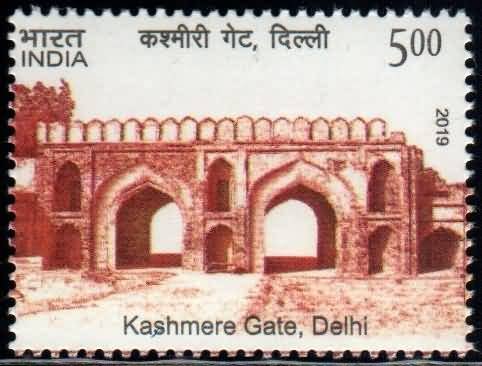Kashmere Gate, Delhi

Technical Data
| Stamp Set | Historical Gates of Indian Forts and Monuments |
|---|---|
| Date of Issue | October 19, 2019 |
| Denomination | Rs. 5 |
| Quantity | 500,000 |
| Perforation | 13¼ x 13¾ |
| Printer | Security Printing Press, Hyderabad |
| Printing Process | Wet Offset |
| Watermark | No Watermark |
| Colors | Multicolor |
| Credit (Designed By) | Sh. Brahm Prakash Sh. Pallab Bose |
| Catalog Codes |
Michel IN 3599A Stamp Number IN 3167 Yvert et Tellier IN 3277 Stanley Gibbons IN 3679 |
| Themes | Fortresses / Strongholds | Gates |
A Historic Northern Gateway to Old Delhi
The Kashmere Gate stands as one of the most prominent and historically significant structures of Old Delhi. Built during the reign of Mughal Emperor Shah Jahan, this gate served as the northern entrance to the walled city of Shahjahanabad and provided access to the magnificent Red Fort (Lal Qila). Its name derives from the direction it faces towards Kashmir — hence called Kashmere Gate.
Architectural Grandeur and Design
The Kashmere Gate exemplifies Mughal architectural excellence, featuring sturdy red sandstone construction, grand arched openings, and intricate detailing that reflects the regal aesthetics of the Mughal era. Originally, it functioned as a controlled entry and exit point for the city’s residents and military forces, ensuring security and order.
During the British period, the gate was strengthened and modified, showcasing an interesting blend of Mughal and colonial architectural influences. It once stood as a critical point of transition between the old walled city and the expanding British settlements, symbolizing the merging of two eras.
Role in the First War of Independence, 1857
The Kashmere Gate holds immense historical importance due to its pivotal role in the First War of Indian Independence in 1857. During the siege of Delhi, the British forces used the gate strategically to launch attacks against the Indian soldiers who had risen in revolt. To breach the defenses, the left portion of the gate was blown up using gunpowder, marking a decisive moment in the rebellion’s final phase.
After the war, the British shifted their administrative center to the Civil Lines, making the Kashmere Gate area a fashionable and commercial hub of Delhi during the late 19th and early 20th centuries — a position it retained until the establishment of New Delhi in 1931.
Modern Legacy and Preservation
In 1965, part of the gate was modified to facilitate vehicular movement, aligning it with the evolving needs of a modern city. Despite these changes, the Kashmere Gate continues to stand as a protected monument under the Archaeological Survey of India (ASI).
Today, it serves as a historical reminder of Delhi’s layered past, bridging the grandeur of the Mughal era, the turbulence of the 1857 uprising, and the transformations of colonial and modern India.
Commemorative Postage Stamp
To honor India’s rich architectural and historical heritage, the Department of Posts issued a commemorative postage stamp on the Kashmere Gate, Delhi, as part of the series on Historical Gates of Indian Forts and Monuments.
This stamp pays tribute to the Kashmere Gate as not merely an architectural marvel but a silent witness to India’s struggle, resilience, and cultural evolution — standing tall as a timeless gateway between history and modernity.

Leave a Comment
You must be logged in to post a comment.